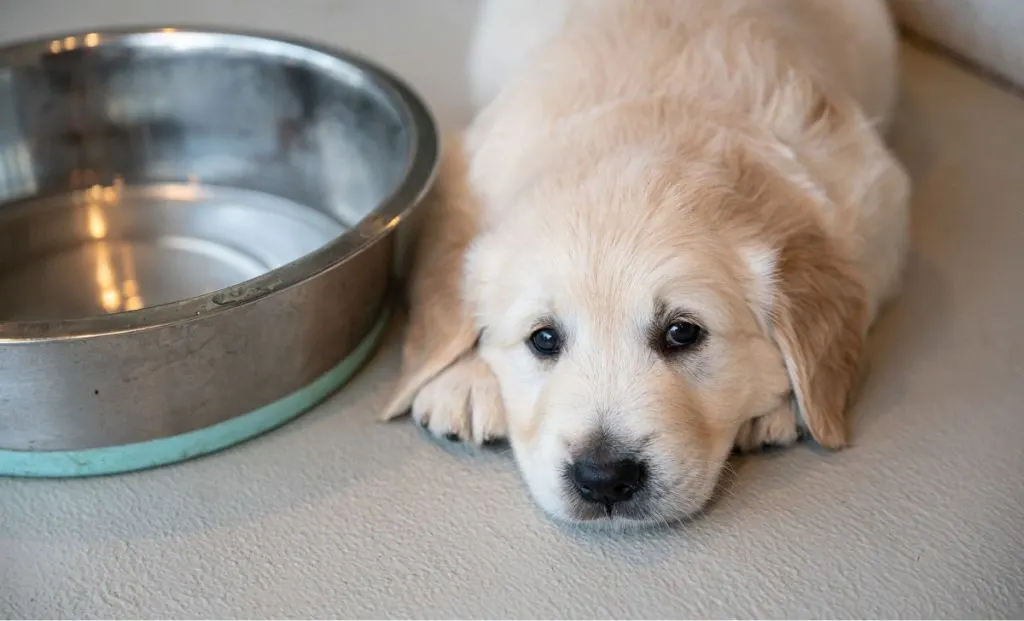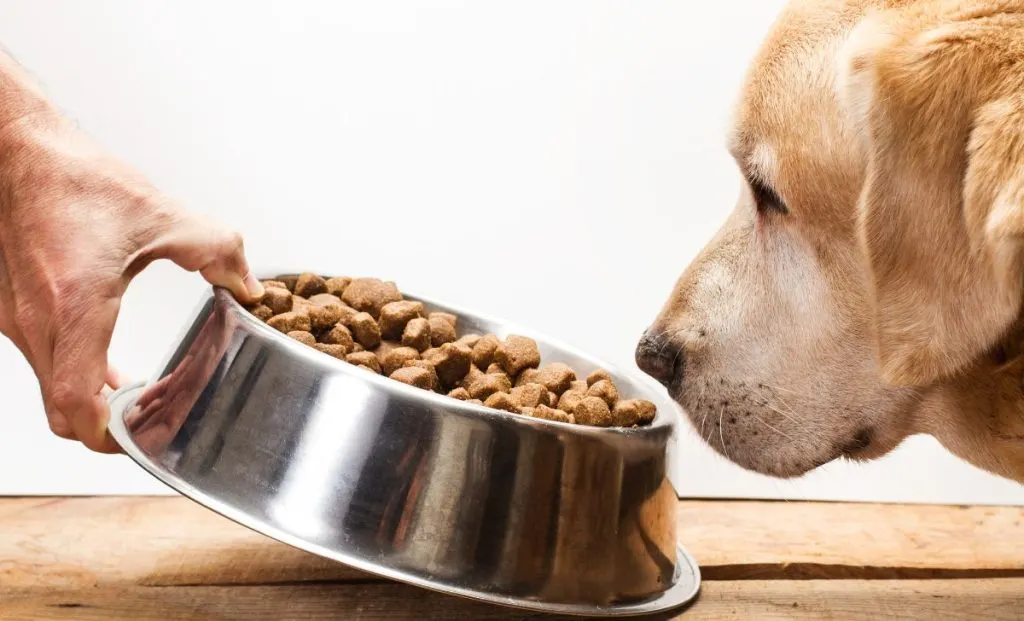Have you just got your new family pet and want to know just how much you need to feed him? A Labrador feeding chart is your best friend, then!
Understanding how much you need to feed your pooch is one of the key aspects of learning how to care for your beloved dog. A dog needs to eat healthily and in the right amounts to grow big and strong.
But, considering just how quickly puppies grow, how can you know you’re giving your dog the right amount of food for his age?
Let’s check out the Labrador feeding guide and see just how much food our furry companion needs:
Labrador Retriever Feeding Chart
| Age | Number of daily feedings | Amount of food per day | Type of Food |
|---|---|---|---|
| <4 weeks | / | / | Mother’s milk |
| 4 – 8 weeks | As needed | As needed | Mother’s milk and puppy food |
| 2 – 3 months | 4 | 7 – 9 ounces | Puppy food |
| 3 – 4 months | 3 | 8 – 10 ounces | Puppy food |
| 4 – 6 months | 3 | 9 – 11 ounces | Adult and puppy food |
| 6 – 12 months | 2 | 12 – 16 ounces | Adult food |
| 1- 8 years | 2 | 12 – 16 ounces | Adult food |
| >8 years | 2 | 12 – 16 ounces | Adult food |
How To Feed Your Labrador Retriever Puppy
Raising a Labrador Retriever from puppyhood is a pawsome journey filled with joy and happy sceneries but also many challenges.
As your little bundles of joy grow, you’ll see their appetite changing. This is where understanding a Labrador feeding chart becomes handy.
Without proper nutrition, your dog won’t get the chance to develop properly. For your dog to grow according to the breed’s growth chart and reach a recommended adult weight, he needs to eat well.
A good diet is essential from day one, and it plays an important factor in a Labrador dog’s development.
Here’s everything you need to know about feeding these large breed dogs from birth to senior years:
Early Nutrition (Birth To 4 Weeks)

From birth to the first month, you won’t have to deal with much – of course, provided your puppies have a healthy mother dog who is taking care of them.
All your puppy needs at this time is his mother’s milk.
The first mother’s milk is called colostrum, and it plays a vital role in your dog’s health. It helps kick start their immune system, keeping them strong and healthy at this fragile age.
If your puppies don’t have a mother who can breastfeed them, things can get a bit more challenging.
Newborn pets should be fed while lying on their stomachs to avoid choking. Feed them a specially formulated puppy milk formula every 2 to 3 hours. The exact amount of milk per feeding should be written on the packaging.
Never use cow’s milk to feed a Labrador puppy! Cow’s milk is too fatty and doesn’t contain the right amount of nutrients a dog needs. Not only that, but it can trigger allergies and food sensitivities, halting your dog’s development.
Weaning Process (4 To 10 Weeks)
As large breed puppies reach the first month of age, they should begin transitioning from mother’s milk to solid foods. This is known as the weaning process.
Your Labrador’s body will change, and he’ll need more nutrients than his mother can provide him with. This is when you should start introducing him to commercial puppy food.
While natural, this process can be trickier than it seems. A puppy’s stomach might struggle to digest solid foods for the first time, so you shouldn’t make any sudden dietary changes.
One way in which you can do this is to try giving your dog puppy food mixed with some warm water between meals and make a puppy mush. This way, he can still choose whether he wants to be fed by his mother or if he prefers the solid food you’re giving him.
Rather quickly, your pup will switch entirely from milk to puppy mush, and this is the time to start giving him solid food.
As this is a huge transitional period, your puppy’s stomach is likely to be very sensitive. You can expect some diarrhea, tummy aches, and changes in appetite. This is all pretty normal, but it is a good idea to contact a veterinarian if you suspect something’s wrong.
Puppy Food Stage (3 – 6 Months)

When it comes to this age, you can finally relax a bit – at least when it comes to feeding. Sure, your Lab puppies will behave like young teenagers, be disobedient, and run all day long, but you won’t have to think too much about what they eat.
Throughout this stage, they’ll stick to puppy food. You’ll still need to give them several small portions a day to ensure they have enough energy to play and grow, but their tummies won’t be as sensitive.
As for the amount, this will greatly depend on the pup’s individual needs.
Growing Fast (6 – 12 Months)
This is the time when your Lab puppy will grow rapidly until he finally turns into an adult dog. His portion size and feeding needs will increase over time to ensure they have enough nutrients for proper development.
Once your Labrador is 6 months old, it’s time to start switching to adult food. For now, I advise giving him wet food instead of dry foods and kibble, as they’ll need to stay hydrated as much as possible.
This transition should go as slowly as the transition to puppy food did. For the first week, mix a bit of adult food with a portion of puppy food. In the second week, increase the amount of adult dog food. Keep increasing, until your dog starts eating food made for adults only.
If you haven’t already, this is the right time to include treats and other types of food. Give your lab plenty of raw meat, veggies, and fruits. Of course, make sure everything you’re giving him is safe to eat.
The vet will be your best friend throughout this time, as you should keep in touch with him in case your Lab pup gets any stomach issues.
Make mealtime exciting and make sure he is eating all the right nutrients. These dogs have high energy levels and need to get all the best ingredients. Feel free to try out different brands until you find the one that will work the best for your pooch.
Adulthood (1 – 8 Years)

Congratulations! Your Labrador Retriever is now all grown up!
During adulthood, you won’t need to change many things in your dog’s diet. Once you’ve found what kind of diet works for him, you’ve hit the jackpot, and there’s really no need to switch things up too much.
Healthy Labrador adult dogs should eat two large meals a day, filled with proteins, fats, and good minerals.
Of course, every dog is different. Some Labs might decide one day they no longer like the brand of food you’ve been giving them, or maybe that they have a new favorite treat. It’s okay to keep introducing your adult pooch to various different meals.
Switching from dry food to kibble from time to time is also a good idea, as it can help keep the dog’s teeth and gums healthy.
Don’t forget that your pup needs to have water available throughout the day. Dogs need hydration as much as we do, and they need to be able to drink whenever they feel like it.
Older Dog (8+ Years)
As your Labrador Retriever ages, his body will start going through changes. His metabolism rate will slow down, and his organ function will start to diminish. Even the most active dogs will start calming down, resulting in muscle mass loss.
Because of this, it’s a good idea to switch to the kinds of foods made with senior dogs in mind.
Older dogs will need more nutrient-dense foods that will ensure their bodies still function properly.
The first thing you should change is the protein source and the amount of protein. Your Lab will need to switch to leaner proteins to prevent the strain on organs such as kidneys.
As older Labs are rather prone to joint disorders, such as hip dysplasia, you might also consider adding supplements to their diet.
Glucosamine and chondroitin sulfate are two ingredients you should definitely include in their diet, as they’ll keep your dogs feeling young for a long while.
Since their metabolisms aren’t as they used to be, they are more prone to weight gain. Make sure to monitor their food intake, especially if they cannot be as active as before due to joint problems.
Finally, it’s time for pet owners to stop giving their dogs snacks! I know this can be hard, especially if your Lab is a beggar, but this is for their own good.
There is no general rule to the amount of food you should give your senior Labrador. Plenty of Labs will still have their large appetite even in older days, but some might not be as interested in food as they were at a young age.
Essential Nutrients
To ensure your Labrador stays healthy throughout his life, you need to give him all the essential nutrients.
Many pet owners are not certain what to look for in the ingredient list of commercial dog foods or what some requirements are when they want to feed Labrador puppies.
Here is the list of all the important nutrients and some good reasons why you should want them in your Labrador dog diet:
Proteins
Foods packed with protein will help the dog’s muscles grow healthy and strong. Because of that, you should always look for foods that have a protein source listed as their first ingredient.
The protein source should always be a type of meat. From poultry and beef to fish, there is nothing that can substitute real meat. This is why raw diet is so popular among many dog owners.
Fats
Dogs also need a healthy amount of fats in their food. NRC guidelines suggest opting for food that has at least 5.5% fat.
Fat helps dogs have enough energy for their daily shenanigans. It also makes the food more palatable and tasty.
Carbs
Carbs are another type of nutrient that ensures your dog has lots of energy. However, they don’t need carbs in the same way we do, as they can get all their energy from proteins and fat.
Still, the best food will always include whole grains and other healthy sources of carbs, just to ensure your active puppies can run that extra mile.
Keep in mind that grains are a common source of allergy in dogs, so this is something you should be mindful of.
Vitamins And Minerals
Vitamins and minerals are important for keeping your Lab’s immune system strong and preventing some common health problems.
For example, calcium and vitamin D are important for bone and joint health, zinc and selenium will boost the Lab’s immune system, and vitamin E is important for skin and coat health – which is very useful if you want to enjoy all the beautiful Labrador Retriever coat colors.
Healthy adult dogs don’t need much supplementation, but older dogs will greatly benefit from it.
Other
There are a few other ingredients that respond to certain unique needs dogs have. For example, omega fatty acids, thiamine, pantothenic acid, and niacin are always a good addition to dog food.
Glucosamine and chondroitin sulfate are also important for keeping dog’s bones and brains healthy, and they are common in senior dog food.
Risks Of Overfeeding
A Labrador feeding chart can be very helpful in preventing you from overfeeding your Lab.
Overfeeding can lead to many health issues, such as bone and joint problems, diabetes, and cardiac problems. A study has shown that a Labrador Retriever who is just slightly overweight will typically live about 2 years shorter than pups that have a healthy weight!
This alone should be a good reason not to give your pooch more food than they need.
One of the reasons behind overweight dogs is that owners forget to count treats when calculating all the calories they are giving their pets. Treats can lead to weight gain, just like any other type of food can.
We all want nothing but the best for our furry companions and want to provide them with the best life possible. To do so, we need to make sure they are healthy, and this includes proper feeding habits.
I hope this article has helped you get a better idea of how much you need to feed your beloved Labrador Retrievers.

Vanja’s passion for writing started at an early age, which is why she pursued Journalism as her college degree. She can research any topic and find all the information before you bat an eye, which is a great thing for her job but a terrible one for her husband.
Even as a young child, she fell in love with everything fluffy – but dogs have a special place in her heart due to her childhood companion, a Corgie named Archie.
Motivated by her experiences and driven by a desire to give back to her four-legged companions, she spends her free time volunteering at a local dog shelter.
